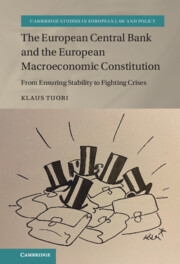 The European Central Bank and the European Macroeconomic Constitution
The European Central Bank and the European Macroeconomic Constitution Published online by Cambridge University Press: 15 September 2022
The Introduction explains how the ECB was established as a central bank mainly controlled and guided by its constitutional framework. When this constitutional model has been challenged by a series of crises, the carefully designed economic constitutional model has been replaced by a constant flow of ad hoc measures that were largely responses to the economic and political realities of the moment. In the euro area, the economic, financial, sovereign debt and finally pandemic crises have also been constitutional crises. The ECB lacks a nation state’s economic and political will-formation as its counterpart and as its ultimate control. Its main counterpart is the constitutional framework, called the European Macroeconomic Constitution. This special model requires a special EU constitutional law approach to assess the ECB’s measures and to guide it going forward. It is a broadly based constitutional law methodology that could also be defined as economic constitutionalism.
To save this book to your Kindle, first ensure [email protected] is added to your Approved Personal Document E-mail List under your Personal Document Settings on the Manage Your Content and Devices page of your Amazon account. Then enter the ‘name’ part of your Kindle email address below. Find out more about saving to your Kindle.
Note you can select to save to either the @free.kindle.com or @kindle.com variations. ‘@free.kindle.com’ emails are free but can only be saved to your device when it is connected to wi-fi. ‘@kindle.com’ emails can be delivered even when you are not connected to wi-fi, but note that service fees apply.
Find out more about the Kindle Personal Document Service.
To save content items to your account, please confirm that you agree to abide by our usage policies. If this is the first time you use this feature, you will be asked to authorise Cambridge Core to connect with your account. Find out more about saving content to Dropbox.
To save content items to your account, please confirm that you agree to abide by our usage policies. If this is the first time you use this feature, you will be asked to authorise Cambridge Core to connect with your account. Find out more about saving content to Google Drive.